Warm up with comforting food and heady tipples near Dongdaemun
With Siberian temperatures and biting winds gripping the peninsula, your motivation to get out and about may be close to zero.
But if hibernating your weekends away is growing dull, a trip to Seoul’s “Little Russia,” for a dose of hearty fare and strong alcohol, is a fitting antidote to the cold weather.
Part of the Central Asia district in Gwanghui-dong, Little Russia offers restaurants and cafes with affordable, piping-hot meals and cozy décor which are bound to bring back a warm glow to your cheeks.
Russians have a history in Korea going back to before Japanese colonialism, but it was not until the late 1980s that the community in Jung-gu began to develop ― mainly made up of clothing traders who wanted to be close to popular shopping district Dongdaemun.
Today, freight companies have set up shop and thousands of people from post-Soviet states and neighboring countries now live or work in the area. People from a whole range of places including Uzbekistan, Kazakhstan and Mongolia are represented in Seoul’s Central Asia, with many being ethnic Koreans.
There is much to explore in the vicinity, but to start with, try three great suggestions to warm up the Russian way:
Tea for two
Russians may be known for drinking vodka, but they’re also keen on a comforting cup of tea to warm-up frosty fingers and aid digestion.
Fortune Café, with its low blue lighting and hushed atmosphere, may not seem instantly inviting, but for a soothing pot of black or green leaves it makes for a great afternoon stop-off. An ornately decorated pot for two, served fresh and unstrained, costs just 2,000 won.
For a tasty snack to go with it, try “samsa”: flaky, glazed pastry with a generous filling of peppery lamb and onions. For the perfect touch of moisture, add some of the sweet and spicy tomato salsa provided.
With Siberian temperatures and biting winds gripping the peninsula, your motivation to get out and about may be close to zero.
But if hibernating your weekends away is growing dull, a trip to Seoul’s “Little Russia,” for a dose of hearty fare and strong alcohol, is a fitting antidote to the cold weather.
Part of the Central Asia district in Gwanghui-dong, Little Russia offers restaurants and cafes with affordable, piping-hot meals and cozy décor which are bound to bring back a warm glow to your cheeks.
Russians have a history in Korea going back to before Japanese colonialism, but it was not until the late 1980s that the community in Jung-gu began to develop ― mainly made up of clothing traders who wanted to be close to popular shopping district Dongdaemun.
Today, freight companies have set up shop and thousands of people from post-Soviet states and neighboring countries now live or work in the area. People from a whole range of places including Uzbekistan, Kazakhstan and Mongolia are represented in Seoul’s Central Asia, with many being ethnic Koreans.
There is much to explore in the vicinity, but to start with, try three great suggestions to warm up the Russian way:
Tea for two
Russians may be known for drinking vodka, but they’re also keen on a comforting cup of tea to warm-up frosty fingers and aid digestion.
Fortune Café, with its low blue lighting and hushed atmosphere, may not seem instantly inviting, but for a soothing pot of black or green leaves it makes for a great afternoon stop-off. An ornately decorated pot for two, served fresh and unstrained, costs just 2,000 won.
For a tasty snack to go with it, try “samsa”: flaky, glazed pastry with a generous filling of peppery lamb and onions. For the perfect touch of moisture, add some of the sweet and spicy tomato salsa provided.
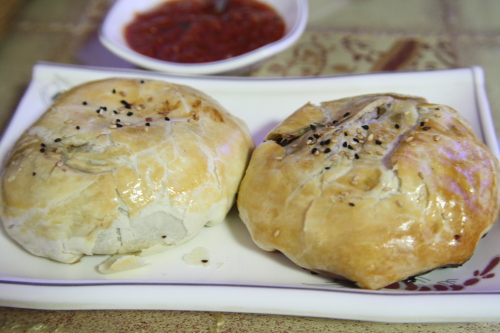
Hearty helpings
To sample a good range of Russian food settle into a restaurant for the evening, with friends or a date, and share some of the salads, soups, kebabs and mains on offer.
Gostiniy Dvor, with its chintzy red décor accented by chandeliers and gold-framed landscape paintings, is well-established and has excellent food.
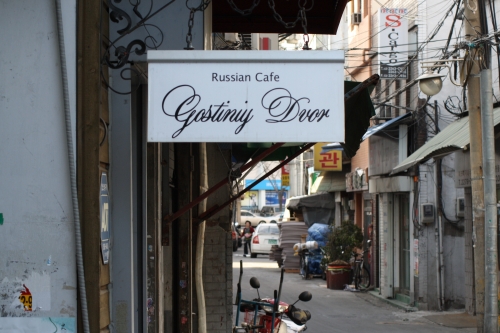
Food here, as in other restaurants in the area, is served on floral crockery, set on paper doilies. This all adds to the charm and the very convincing feeling that you are no longer in Korea.
The menu, written in both Russian and English, is clear and easy to navigate even if this is your first taste of Russian cuisine.
The salad menu is extensive and ranges from “vinaigrette,” a mix of boiled beetroot, onions, pickled cucumbers and potatoes, to “bird’s nest,” which is chicken fillet, cheese and egg. But for something a little warmer to begin your meal with during these chilly winter months, head straight for the soups.
The borscht comes recommended by the waitress here, being one of Russia’s most famous exports. The satisfying, but pleasantly light, shredded-beetroot broth has a silky texture and a sweet aftertaste. Complimented by a dollop of cool sour cream, it slips down gloriously.
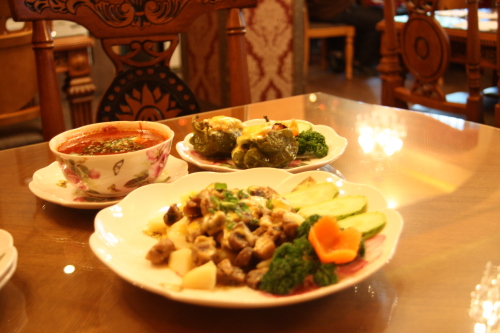
But if that is not to your taste, there is plenty more on offer, including a lemon and dill fish broth and “solyanka,” or what the menu describes as “traditional Russian pizza soup.“ Rye bread, for an extra 2,000 won, is great for mopping up every last morsel.
The choice of mains makes for a difficult decision, especially as most cost only 10,000 won. It’s better to share than to over-order, however, as a lot of the dishes come rich and heavy ― meat, especially lamb, is prominently featured.
Safe and recognizable favorites include cabbage rolls, lamb ravioli and house marinated pork chops ― none of which disappoint, all being ample sustenance by themselves if you’re just stopping by for a quick bite.
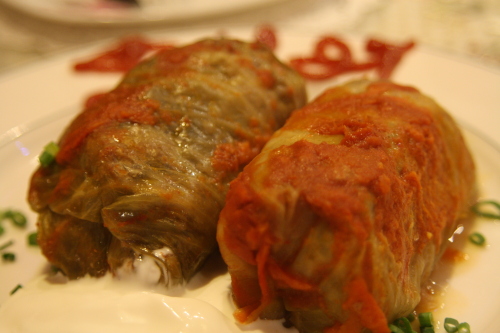
The stuffed green bell peppers, “a Russian delight,” come filled with pork, chicken, carrots and rice, and are topped with creamy melted cheese ― the result is uncomplicated and pleasantly salty. For complimentary carbs, opt for “Russian-style Julien.” This dish is a mix of soft, buttery potatoes, baked mushrooms and seasoned chicken chunks.
To wash all this down, choose a Russian beer ― but first decide how tipsy you plan on being. Beers here are numbered according to strength, but stronger doesn’t mean more expensive. Baltika, for instance, ranges from No. 3 (4.8 percent alcohol), a crisp and fresh-tasting pilsner, to No. 9 (8 percent alcohol), which is a malty, more intoxicating version. But all varieties cost the same: 5,000 won.
Naughty but nice
So at last to the vodka. If you were too focused on the food during dinner, it’s a great way to finish off, especially if chased up with a citrusy, palate-cleansing juice such as orange, cranberry or apple. And while you’re being indulgent, tuck into some tempting after-dinner treats too; Russians, like Koreans, like to eat while they drink.
Duet has a bright and chatty atmosphere, akin to a bar, as most people drink and eat snacks under softly-blinking blue, green and red lights. Russian radio plays European pop in the background, adding to the upbeat feel of the place.
A hundred grams of vodka (approximately four shots) served in a miniature cut-glass carafe, with two shot glasses, costs 6,000 won. But if you want to make a night of it, you can buy bottles of Russian vodka for about 20,000 won. Brands include Russian Ice, Myaghov and Hortitsa. For Absolut, expect the price to double.
As with their savory courses, Russians don’t take their deserts lightly ― so leave plenty of room. There are no dainty sherbets or delicate fruity confections to be found here.
Duet’s pancakes, smothered in melted butter with a dripping of zesty honey atop, are easy to nibble on even after a big feast. A floral dish of four costs only 4,000 won. Other desserts, mostly pastry or dough-based such as sturdy, soft cheese-filled pancakes, are also tasty but more substantial.
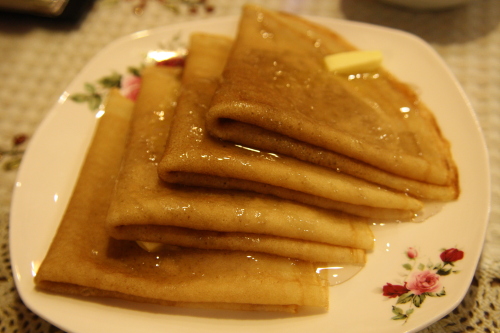
Russian produce
As the hub of the Russian community in Seoul, Little Russia ― as well as cafes, restaurants, churches, karaoke rooms and workplaces ― also has shops where Central Asian products can be purchased.
Rata bakery, two buildings down from Fortune Café, is well worth a look ― step inside for freshly-baked hefty beef and lamb-filled pastries and shelves of sticky sweets. You can eat-in, but there’s not much space so it’s a good place to pick up something to eat while you stroll.
Across the street from the bakery is Katrin, a store where you can buy pirogues, dumplings and other frozen and canned goods popular in the region. Amid a scattering of Korean products, you will also find Russian chocolates, liquor, newspapers and a curious array of toys and jewelry.
Directions
Navigating Little Russia may seem a little intimidating at first with its industrial feel and Cyrillic script. But you will find all the places above within a short distance of Dongdaemun History & Culture Park Station, Exit 7.
All establishments are on the main road to your left as you leave the station, apart from Gostiniy Dvor which is on the road that runs behind Exit 7 and has a white sign reading “Russian Café.”
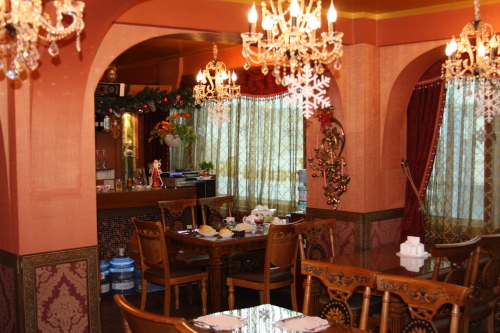
The area isn’t particularly scenic, but a wander through the alleys can be highly rewarding. As the main language spoken here is Russian, followed by Korean, your best bet is to let yourself be guided by unfamiliar signage ― not deterred by it.
Info box
Fortune Cafe
Tel: (02) 2263-8799
Gostiniy Dvor
Tel: (02) 2275-7501
Duet (second floor, no English sign)
Tel: (02) 2269-0297
Rata Bakery
Tel: (02) 2278-9
By Hannah Stuart-Leach (hannahsl@heraldcorp.com)Fortune Cafe
Tel: (02) 2263-8799
Gostiniy Dvor
Tel: (02) 2275-7501
Duet (second floor, no English sign)
Tel: (02) 2269-0297
Rata Bakery
Tel: (02) 2278-9











![[Today’s K-pop] BTS pop-up event to come to Seoul](http://res.heraldm.com/phpwas/restmb_idxmake.php?idx=644&simg=/content/image/2024/04/17/20240417050734_0.jpg&u=)





![[KH Explains] Hyundai's full hybrid edge to pay off amid slow transition to pure EVs](http://res.heraldm.com/phpwas/restmb_idxmake.php?idx=652&simg=/content/image/2024/04/18/20240418050645_0.jpg&u=20240419100350)

